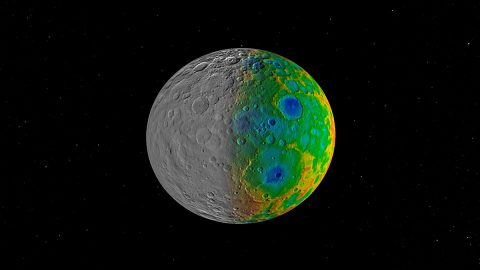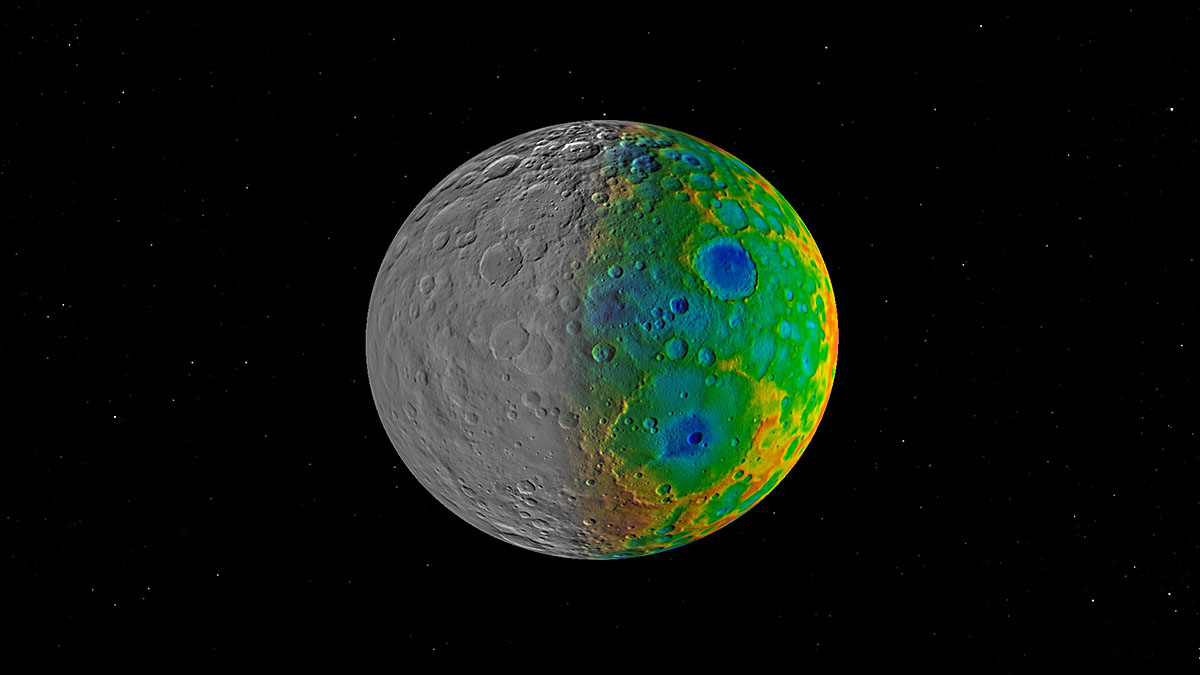Written by Elizabeth Landau
NASA’s Jet Propulsion Laboratory
 Pasadena, CA – Ceres is covered in countless small, young craters, but none are larger than 175 miles (280 kilometers) in diameter. To scientists, this is a huge mystery, given that the dwarf planet must have been hit by numerous large asteroids during its 4.5 billion-year lifetime. Where did all the large craters go?
Pasadena, CA – Ceres is covered in countless small, young craters, but none are larger than 175 miles (280 kilometers) in diameter. To scientists, this is a huge mystery, given that the dwarf planet must have been hit by numerous large asteroids during its 4.5 billion-year lifetime. Where did all the large craters go?
A new study in the journal Nature Communications explores this puzzle of Ceres’ missing large craters, using data from NASA’s Dawn spacecraft, which has been orbiting Ceres since March 2015.

Marchi and colleagues modeled collisions of other bodies with Ceres since the dwarf planet formed, and predicted the number of large craters that should have been present on its surface.
These models predicted Ceres should have up to 10 to 15 craters larger than 250 miles (400 kilometers) in diameter, and at least 40 craters larger than 60 miles (100 kilometers) wide.
However, Dawn has shown that Ceres has only 16 craters larger than 60 miles, and none larger than 175 miles (280 kilometers) across.
One idea about Ceres’ origins holds that it formed farther out in the solar system, perhaps in the vicinity of Neptune, but migrated in to its present location. However, scientists determined that even if Ceres migrated into the main asteroid belt relatively late in solar system history, it should still have a significant number of large craters.
[youtube]https://www.youtube.com/watch?v=6h6HzmuUOuI[/youtube]
“Whatever the process or processes were, this obliteration of large craters must have occurred over several hundred millions of years,” Marchi said.
Dawn’s images of Ceres reveal that the dwarf planet has at least three large-scale depressions called “planitiae” that are up to 500 miles (800 kilometers) wide. These planitiae have craters in them that formed in more recent times, but the larger depressions could be left over from bigger impacts.
One of them, called Vendimia Planitia, is a sprawling area just north of Kerwan crater, Ceres’ largest well-defined impact basin. Vendimia Planitia must have formed much earlier than Kerwan.
Recent analysis of the center of Ceres’ Occator Crater suggests that the salts found there could be remnants of a frozen ocean under the surface, and that liquid water could have been present in Ceres’ interior.
Past hydrothermal activity, which may have influenced the salts rising to the surface at Occator, could also have something to do with the erasure of craters. If Ceres had widespread cryovolcanic activity in the past — the eruption of volatiles such as water — these cryogenic materials also could have flowed across the surface, possibly burying pre-existing large craters.
Smaller impacts would have then created new craters on the resurfaced area.
“Somehow Ceres has healed its largest impact scars and renewed old, cratered surfaces,” Marchi said.
Ceres differs from Dawn’s previous destination, protoplanet Vesta, in terms of cratering. Although Vesta is only half the size of Ceres, it has a well-preserved 300-mile- (500-kilometer) -wide crater called Rheasilvia, where an impacting asteroid knocked out a huge chunk of the body.
This and other large craters suggest that Vesta has not had processes at work to smooth its surface, perhaps because it is thought to have much less ice. Dawn visited Vesta for 14 months from 2011 to 2012.
“The ability to compare these two very different worlds in the asteroid belt — Vesta and Ceres — is one of the great strengths of the Dawn mission,” Marchi said.
UCLA is responsible for overall Dawn mission science. Orbital ATK Inc., in Dulles, Virginia, designed and built the spacecraft.
The German Aerospace Center, Max Planck Institute for Solar System Research, Italian Space Agency and Italian National Astrophysical Institute are international partners on the mission team.
For a complete list of mission participants, visit:
http://dawn.jpl.nasa.gov/mission
More information about Dawn is available at the following sites:



